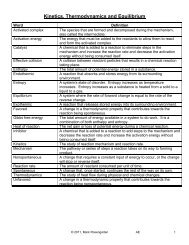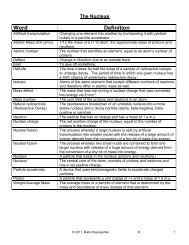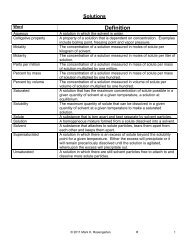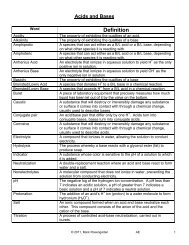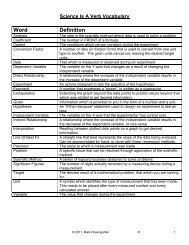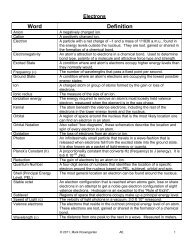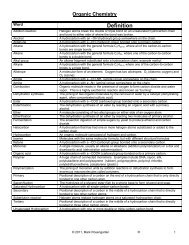Unit 5 - Mark Rosengarten
Unit 5 - Mark Rosengarten
Unit 5 - Mark Rosengarten
You also want an ePaper? Increase the reach of your titles
YUMPU automatically turns print PDFs into web optimized ePapers that Google loves.
1) The History of Atomic Structure: The Electron (HW: p. 21, 22)<br />
Essential Question: How does knowledge evolve with the help of technology?<br />
Technology Drives Science Drives Technology<br />
The history of the structure of the atom is a story of technological innovation that led to our idea of what an atom looks<br />
like today. There were several key people along the way that made contributions to our current model of the atom. In<br />
the beginning, philosophers thought af the atom as being solid, with no separate parts. Gradually, as technology<br />
improved, scientists were able to see more deeply into the nature of the atom, first discovering the electron, then the<br />
nucleus, and then what the electrons were doing, in energy levels and beyond. It is remarkably similar to the history<br />
behind our idea of what the universe is. That started out as Earth as the only thing in the universe, with a shell around<br />
it where all of the heavenly bodies were stuck, like glow-in-the-dark stickers on the walls and ceiling of your bedroom.<br />
Think of the progression of the telephone over the years! They started out as hand-cranked, wall-mounted pieces.<br />
You spoke into a cone on the wall, and held the earpiece (connected by cable) to your ear. Gradually, they merged<br />
the two into the handset, connected to the main part of the phone with a cord to give you some mobility. They they<br />
invented the speakerphone, which left you hands-free. Then the cordless phone, so you could take your conversation<br />
anywhere in the house. Then the cell phone, so you could take your call anywhere in the world! As technology<br />
improved, so did the telephone. The same is true of our concept of what the atom is.<br />
What Is A Model?<br />
Like a model airplane or a map of the world, the model of the atom is a representation of something real. Since atoms<br />
cannot be directly seen, their existence has to be inferred from experimental observations. Atoms fit our observations<br />
about the behavior of matter, so we hypothesize that they exist. The same thing goes for the parts of an atom. No<br />
one has directly seen protons, neutrons or electrons, but their existence is inferred from experimental observations.<br />
As technology improves, our concept of what an atom is get sharper as we can do better experiments. It’s like viewing<br />
a mountain from a distance. To our eye, it is a grayish mass with a mountainy shape. This view tells us nothing about<br />
the mountain. Once binoculars were invented, we could get a somewhat closer look. We could see that the mountain<br />
had hills and bumpy stuff that is still not recognizable, but we have a better idea of what the mountain is made of.<br />
Then the telescope is invented and we can now see that the mountain has trees, boulders, grassy areasthe picture<br />
of what the mountain is all about becomes clearer.<br />
The same applies to mapmaking. In the old days, the only technologies available for mapmaking were ships, sextants,<br />
clocks and eyeballs. Based on observations of the position of the sun and stars, a sailor could roughly determine the<br />
ship’s latitude and longitude. The photograph on the next page shows a map that was made by this method. Once we<br />
developed aircraft, we were able to get above the features we were mapping. Radar allowed us to map elevations, so<br />
now our model was three-dimensional. Nowadays, we have satellites that can very accurately map the planet, and<br />
many space probes have mapped the surface of Venus and Mars. Saturn’s moon Titan has also been mapped, and<br />
plans are underway to map Mercury.<br />
As technology improves, our picture of the universe around is gets sharper and more defined. Observations are only<br />
as good as the technology that helps us make them. Better science leads to better technology which leads to better<br />
science, and the cycle continues.<br />
The next few pages will walk you through the development of our model of the atom, starting with a couple of Greeks<br />
philosophizing about the nature of matter and ending with our most current model, the Quantum-Mechanical Model.<br />
© 2011, <strong>Mark</strong> <strong>Rosengarten</strong> R 2



